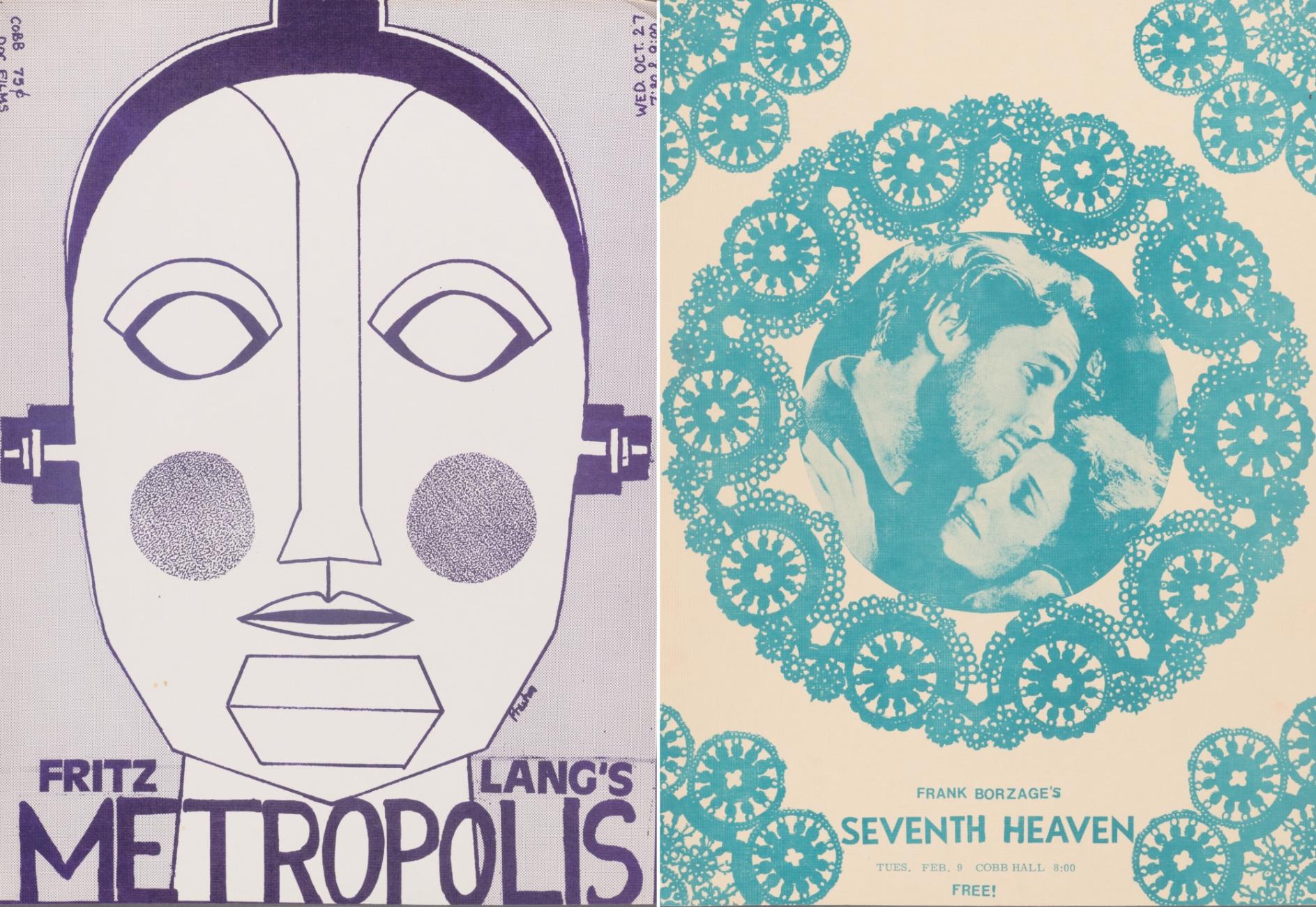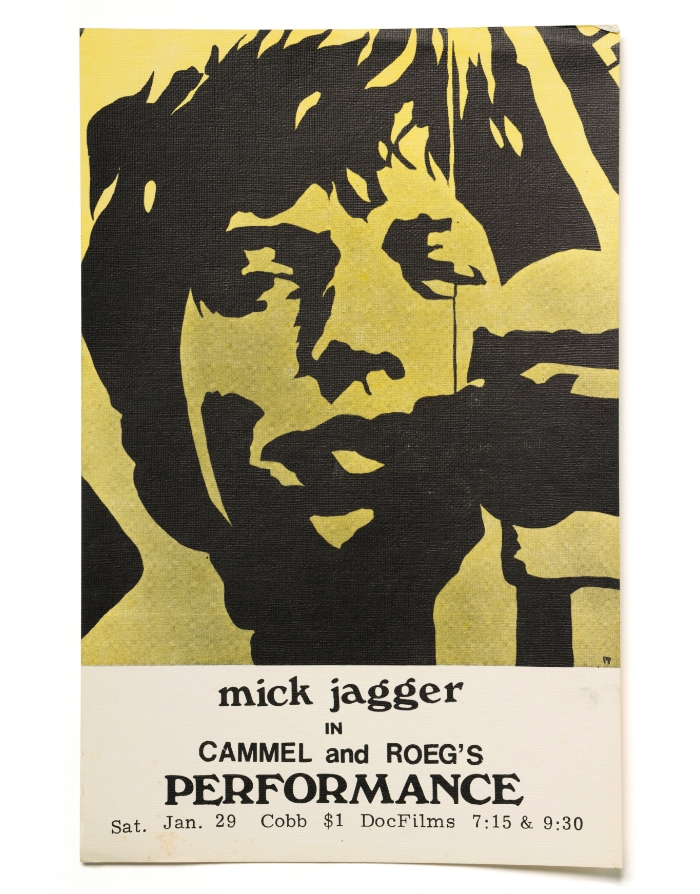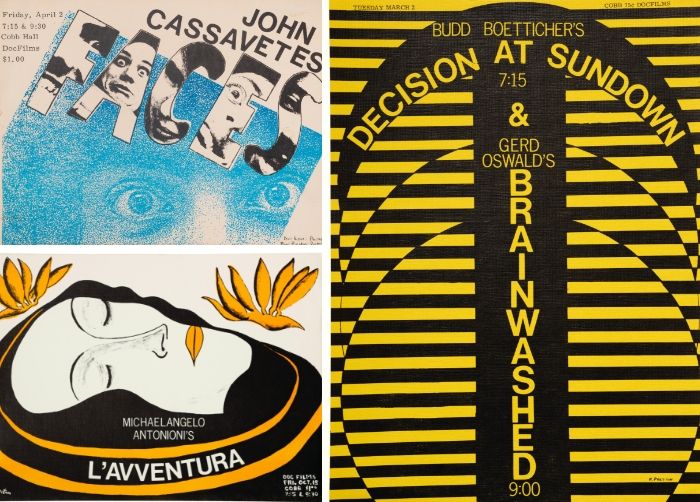
Seen and not heard: Doc has screened plenty of silent films over the years, including this pair from 1927. Fritz Lang’s visionary sci-fi epic has been shown 16 times compared to five Doc appearances by the lesser-known Seventh Heaven. (Documentary Film Group Records, Hanna Holborn Gray Special Collections Research Center, University of Chicago Library; photography by Nathan Keay)
Doc Films turns 90. An alum hits middle age (and then some). The shared memories are timeless.
What was your first movie at Doc?
I can’t remember mine. It would be great to say I dove right into the international and auteurist fare that has been the Documentary Film Group’s signature for 90 years. The offerings during my first quarter in the College (Autumn 1985, if you want to check your old calendar) included “Wim Wenders and His Influences” on Wednesdays, alternating Thursdays of John Cassavetes and Robert Altman, and a Raoul Walsh night. But given my intense homesickness those first ten weeks in Hyde Park, I’m sure I stuck with the comfort cinema screened each weekend: The Breakfast Club and Star Trek III: The Search for Spock leap to mind. Watching them again, even if it was on 16mm in the echoing linoleum cavern of Cobb Hall’s Quantrell Auditorium, I could imagine I was back in Minneapolis at the Skyway or the Uptown.
Fridays and Saturdays ruled in winter, as I curled up with Ghostbusters and Mad Max Beyond Thunderdome, but I also dipped my toes into weeknights via a Brian De Palma series, catching Obsession and Dressed to Kill (I’m 18 now, baby!). The big event of the quarter was the triple feature of Star Wars (no “Episode IV” nonsense for the Doc calendar), The Empire Strikes Back, and Return of the Jedi. Half our house went, and all of us had seen the movies countless times; but watching them again with an older, wiser, nerdier cohort was worth the permanent spinal damage inflicted by seven hours in Quantrell’s unyielding seats.

By Spring Quarter, I was often at Doc several times a week. A group of us went to see Werner Herzog’s Nosferatu the Vampyre. A friend dragged me to Jules et Jim, which he’d fallen for in high school. Richard Rush’s The Stunt Man, with Peter O’Toole’s crane-riding director swooping in and out of the frame, was like nothing I’d ever seen. (It would be a few more years before I caught up with Federico Fellini’s 8 1/2.)
Weekend movies that quarter screened under the series banner “Last Tango at Cobb,” a nod to the Bertolucci movie on the schedule and the bittersweet fact that it was Doc’s last full quarter on Cobb Hall’s second floor. The following October, the Max Palevsky Cinema in Ida Noyes opened with a premiere of Jonathan Demme’s Something Wild. The god of cool after working with Talking Heads on Stop Making Sense, Demme was at the early gala-ish screening with then-president Hanna Holborn Gray and Palevsky, PhB’48, SB’48 (who, after helping bankroll Intel, had produced several Hollywood Films starting in the 1970s). On a whim, some friends and I cut short a Tuesday night at the Reg to attend the later showing—not a bad way to stumble onto what remains my favorite movie. (Mi scusi, Don Corleone.)
The 35mm projectors and improved sound in Palevsky made it the ideal place to revisit Aliens, Platoon, and Die Hard. (Where else is Alan Rickman’s “Benefits of a classical education” line going to get the biggest response of the night?) The new home also reinvigorated the weekend wordplay on Doc’s calendars, which could now run with “Gorillas in the Max,” “Dances with Maxes,” and “The Last Temptation of Max.” But nothing can top the epic name for Winter 1990. Someone saw “Doc the Right Thing” just sitting there, but they went for the brass ring instead: “It’s the Coldest Night of the Weekend, You Can Do Nothing, You Can Do Something, or You Can Do the Doc Thing!”

No weekend at Doc was complete, however, without the next-day rehashes at our house table in Burton-Judson. Teasing out the Kafka references in Scorsese’s After Hours. How did a friend’s strategic mistake of a first date at Blue Velvet go? (Better than expected: 35 years later, they’re still married.) The stunned, sheepish, that’s-not-my-Playboy averted glances the morning after many of us saw 9 1/2 Weeks. The first-year sitting down to breakfast with no eyebrows, as if answering the prompt Tell us you just saw Pink Floyd: The Wall without saying a word. Mercilessly razzing our RA when he told us, “You guys don’t get St. Elmo’s Fire because you’re not about to graduate and leave all this behind.”
Today, much of my DVD and Blu-ray collection is a catalog of movies I first saw at Doc: Quadrophenia. Klute. Paris, Texas. My Beautiful Laundrette. Kurosawa’s Ran. True Stories. Bill Duke’s Deep Cover. Kieślowski’s Three Colors trilogy. Way too much Jim Jarmusch and Mike Leigh. Call it mildly pretentious in a Eurocentric way if you want (you’ll also find Animal House, plenty of Schwarzenegger, and a near-complete set of Tony Scott’s work mixed in there); it’s half-art, half-nostalgia for me.
I can’t remember the first movie I saw at Doc. I do remember the last thing I saw there, because I wouldn’t be in a movie theater again for more than two years. On February 22, 2020, I drove down to Hyde Park from the North Side to see Jane Campion’s An Angel at My Table. I’d meant to see it for years, and Doc showing a nifty new print seemed the perfect opportunity.
Doc has survived the ongoing pandemic and the onslaught of streaming. (Who’s going to say it’s more fun to watch Dazed and Confused on a laptop in their dorm room than to sink into Aerosmith’s “Sweet Emotion” and Matthew McConaughey’s drawl with 300 fellow moviegoers?) All the other theaters I trekked to from Hyde Park back in the day—the Fine Arts on South Michigan Avenue; the United Artists in the Loop; the Esquire, Water Tower Place, McClurg Court, and Chestnut Station north of the river; the Biograph in Lincoln Park—are gone. The Doc abides.
